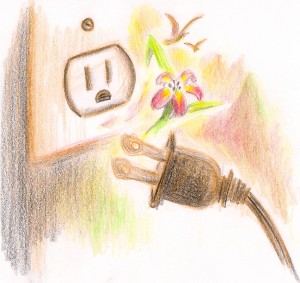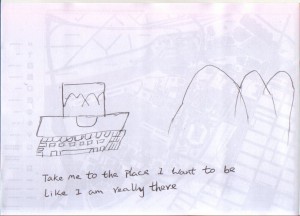Waldorf News
Simplicity Parenting and Waldorf Education: Kim Payne

We caught up with Kim John Payne in Boulder, CO. He was there to work with Shining Mountain Waldorf School, which is in the second year of a three-year process implementing his Social Inclusion Approach. Shining Mountain is one of a large and growing number of schools working with this Waldorf-based approach to further social health and develop ways to work with exclusion, teasing and bullying. He also gave two lectures, one for the parents on “Social Inclusion” and one for the public on “Simplicity Parenting”. “Simplicity Parenting: How to Raise Calmer, Happier and More Secure Kids” is also the title of his most recent book, now in paperback from Random House.
The first thing I wanted to do was to congratulate you on the success of your latest book. “Simplicity Parenting” has become a national phenomenon.
Thank you. I had hoped when the book came out that it would create an opportunity for the Waldorf schools to use the message of Simplicity Parenting to reach out. There are a huge number of parents who have resonated with the message of the book who haven’t yet discovered Waldorf education. It’s a message that can bring us together with a much broader community.
You visit a lot of schools in the course of a year. What would you say is the theme of the moment or the question of our time for parents?
There are two things. Firstly, “How do I deepen and strengthen my connection to my children and my partner?” Secondly, “How do I live in this ‘post-excess’ era?” We see what excess has done to our planet, our economies, in the realm of technology and also education. Now, people are waking up to the effect of the post-excess era on families. They see that it’s had a large and stressful effect on their families.
How is it affecting families?
It’s creating a “soul fever”. Families are living their lives at a feverous pitch of emotion. The problem is that the fever is the new normal. The layers have been burnt off our families like the layers around our planet. People are recognizing this more and more and are seeking to strengthen and repair the layers around the family.

What role do you see Waldorf education playing in this?
Waldorf schools have been leading the way in honoring childhood and promoting balance in family life. Our job is to communicate this message to the wider public. Our roots go deep in this area. We know it, we’ve studied it, and now our task is to articulate it. We need to encourage each other and get out there and spread the message of what we do.
Sometimes we forget that Rudolf Steiner was a social activist and a radical in his time. He was constantly engaged with spreading the message of a new education and social order.
Rudolf Steiner said that teachers were charged with the two tasks of educating children and social renewal.
That’s right. The recent economic collapse is seen by some as a recession, and by some as a correction. I see it as neither. It’s a re-direction, a perfect time to say what our core message is. How do we become social activists in our community?
How can it be that we have the largest independent school movement in the world and you go to some universities and they’ve heard very little about it? Now is the time to go “wide as well as deep”. We’ve spent years developing depth through our work and study. How can we frame our message so that it’s not an enrollment drive, but a message that we can take from conferences to dinner parties and to a much broader audience?
That’s been the effect of the Simplicity Parenting movement. The majority of the parents that are involved don’t have their kids in a Waldorf School.
The book has attracted national attention. What do you attribute that to?
The secret of Simplicity Parenting and the reason that it works is that parents can begin to simplify. Simplicity Parenting offers them modest beginning points. You don’t have to become the perfect Waldorf parent. It’s thrilling to see parents doing simple things and getting started now. It’s given them a direction. People can find a beginning point that feels natural to their family.
If you just begin by cleaning up the toys, you’re already on a path. You can do it in your own way and you can find support. People say support makes all the difference.
What form does that support take?
Waldorf schools are participating by working with a trained Simplicity Parenting group leader. The group leader conducts a series of seven thoughtful and process-oriented parent education evenings over a fourteen week period. Parent education, that’s the first thing. It’s wonderful to read on our blog and hear first hand from the participants how they become like “cheerleaders for each other’s change.” We also see that schools are partnering with Simplicity Parenting group leaders to take the message “out” into the community. We’ve been developing a parent education process that class teachers can use themselves. We give them simple guidelines and then support them further. I think of this as a “campfire” movement. We’re lighting campfires and the warmth from the campfire glows and grows.
More and more children are coming with challenges. What are we to do as educators and parents to meet this challenge of our time?
On one hand we’ve got resources and on the other depth. We benefit so much by going deeper into the amazing riches that Waldorf education brings. The early works and lectures are more relevant than they’ve ever been. How do we apply this to the contemporary child? What do these things mean when we look at a child having difficulty incarnating?
The typical pattern of incarnation isn’t happening in the way that the “textbooks” say. I can give one example here. How does one understand Asperger’s syndrome and autism? If we consider Asperger’s, it’s often put on a continuum with autism. In terms of the ego and the gesture of the finer bodies, it’s almost a polarity.
For a child with Asperger’s, the finer bodies are layered too thickly. The ego has difficulty penetrating through these. It’s almost an ego entrapment. With these children it helps immensely to increase the arts and drama. They’re great at acting and excel with a script. In this case the metabolic, or upbuilding activity of the etheric body, is too strong for the astral body’s catabolic process, which digests and breaks apart.
With autism, it’s the flip side of the spectrum. The astral body is too strong. The etheric, or life body, is gossamer thin. Autism is normally treated through stimulation. However, to strengthen the etheric we need to give the child things of beauty which strengthen the life body. Beautifully carved wooden toys and objects that quietly invite exploration are just one example of how we avoid overwhelming the acute sensitivity of the child. This creates a stronger vessel for the slowly incarnating ego.

When you work with younger teachers, do you see a difference in what they are bringing as questions as opposed to a generation ago?
Young teachers want to know what all of this means for contemporary times. Rudolf Steiner was an action-based researcher and spoke to the teachers of his time, but left many indications for future generations as well. One thing that young teachers respond to is when we approach these modern questions in terms of the four-fold human being, like I did when I explained the polarity of Asperger’s and autism in terms of the four-fold human being. It’s very hopeful that young teachers are striving for specific examples.
How can we support students, teachers and parents with the social forms that we have in schools?
Schools need to set up structures in the school to deal with social health and inclusion. We need to be conscious when we set up these structures. It’s a new thing for teachers to train in how to create a healthy social environment in the adult community.
Our teacher training institutions find it difficult to attract students in a life space to undertake two or three years full time training as it was in the past. The time in training has reduced. Instead they rely partly on skills of the mentors of these young teachers once they are in the field. This seems like a pretty sound strategy, as we do have many very skillful teachers well-versed in guiding a new teacher through the curriculum.
What we are yet fully to wake up to is that there are far fewer mentors who have made a specific focus of the social, emotional and behavioral aspects of our daily life with the children or how to work with the increasing interest of parents in the their child’s life at school. It stands to reason that while our students are training they need a significantly great focus on the social life of the child so they can work with confidence in this area once in the classroom. As one teacher trainee said to me recently, “We get so much wonderful curriculum preparation on our training. It was all curriculum, curriculum, curriculum but after our first practicum we realized to survive as a teacher it was going to be all social, social, social and not just with the children, but with colleagues and in particular with the parents”
You could say that for us as modern human beings, the only thing that we have in common is that we have nothing in common. The social forms that supported us in the past have died away and we are left with this “existential after-image”, which can leave us feeling lonely and disoriented. By creating new and commonly agreed upon social forms we can move ahead. The conversation to get there helps us move up to the transcendent or ethical individual. How we handle individualism is a key question for all of us. The challenge for a teacher now is how to be a creative human being and how to stay true to oneself, while welcoming the process that leads us towards commonly agreed social forms.
What about technology, which many people, not just in the Waldorf movement, see as a threat to childhood and the emergent individual?
Just five years ago, the average child in the US had 4.7 hours per day of screen time. This year it’s 7.5 hours, and that doesn’t include the time in school in front of a screen of some sort. While the figure of 7.5 hours per day in front of a screen is disturbing to most folk, the other worrying realization from this report is how rapidly the hours have grown since 2005.
If you do the math on this trajectory it is a rallying call for action. Chief amongst the many concerns I carry for the digital overwhelm so many of our children are suffering is the strong tendency for this activity to lead our children into addiction. My dear friend Felicitas Vogt once defined addiction as “An increasing and compulsive tendency to replace inner development and avoid pain, silence and boredom, by creating outer stimulation”. Just as a drug user needs more and more of the substance to gain the same “hit”, our children are craving an ever-increasing screen exposure, both in time spent and the power of the images they watch. It’s not only a question of what they are exposed to when in front of a screen it is equally about the doorway to addiction that they are opening wide. This is a doorway into which many other very troubling dynamics can enter.

“Take me to the place I want to be like I am really there” -Natalie, age 10– her drawing of a keyboard and monitor.
How does this very high use of screens today compare to the amount of screen time we were exposed to as kids
Some parents, usually fathers, comment to me that we watched a lot of TV when were growing up and we are OK (maybe on a good day). My reply is based around the hard neuro-science that it takes the average 12-year-old just under 4.0 seconds to see an image and make full meaning of it. Now, consider an episode of Mr. Rogers or the like from the 1960s. The camera pans, zooms or switches very rarely. Long sequences can go by before something as “dramatic” as a camera change happens. It gave time, time for the information and image to be absorbed. Watching television or playing a video game now involves very rapid change of images and even split-screen-flashing, and strobe-like images.
Recently I had a day to fill in a hotel as my plane was cancelled. I decided to take advantage of the television, video game and high speed internet facilities to do some rough comparisons of the difference between Mr. Rogers and contemporary TV and video games.
I gave myself six hours of watching and playing. As I settled in front of a monster sized flat screen I secretly thought that this could be fun. Firstly, I watched three episodes on my computer of Mr. Rogers and one of Father Knows Best. On average, the camera image shifted once every 50-70 seconds. OK, this was not going to be too bad. I then watched a series of television programming and played video games that, according to the information I found, were made for 4 to 9-year-olds. The only comparison to the 1960s is that drug users back then used to pay a lot of money to have that kind of out of body experience. The average image shift happened about 90 times per minute.
So the bottom line is, that to be exposed to the same amount of image flashes and shifts we would have to watch 900 hours of Mr. Rogers to be in the same ballpark as modern screen demands of our children in just one hour! So the argument that “We are OK so our kids should also be OK watching TV” is a little shaky.
As I was watching “modern kids stuff”, I was rapidly marking down in one column on a pad of paper the number of times the images flashed, and in another column when the images were aggressive, which involved doing someone bodily harm. Including the video games which I selected at random from the hotels menu and television, around 36% were violent. If I put together the national average of 7.5 hours a day of using screens with my numbers this means that the average American child is seeing over 7000 violent images each day. I realize that this is not exactly empirical data but kind of interesting to say the least.
In your book Simplicity Parenting you talk about four levels of simplicity. Do these have any relationship to the social issues you work with?
Yes, these are successful methods of simplifying that we noticed parents implementing rather than ourselves “constructing” and teaching. They sure seem to reduce stress on children and their parents. However, the effect of balancing a child’s life goes deep. When a parent brings a child to me to help them with social issues like being teased or bullied at school or home, the place we begin is to look at what is making the child a target. The answer in a vast majority of situations is clear. They are reacting and giving the children who are bullying “mean fun”. They react because their lives are often too fast, unfiltered and unpredictable.
It has been very moving over the years to see how many children are dramatically helped to end the cycle of teasing, become more socially resilient and make good friends when their parents have the courage to bring greater balance and simplicity into the family’s life. This change happens quickly and kids can “get their shape back” within weeks. They are amazed at how the teasing eases as their resiliency grows and the children bullying them lose interest.
These four realms for simplifying are:
- Environment: De-cluttering too much stuff at home. The average child in North America has over 150 toys, countless books and clothes all crammed into their bedrooms. Many parents comment that after creating toy, book and clothes “libraries” and creating a simple and spacious feeling in their bedrooms and playrooms there is a surprisingly dramatically positive effect on their children’s behavior.
- Rhythm: Increasing predictability by introducing rhythmic moments for connection and calm. I have noticed how rhythm creates a sense of external governance and support for young children that is only neurologically available to them as they approach their tweens and particularly their teens. A young child who has the feeling of predictability in home life, a sense of “we do” in this way, later is much more likely to develop the strong ego forces of “I am”. Also, a simple formula has helped countless parents. Wherever there is behavioral difficulty (for example, bed time or meal times), increase rhythm. I know that sounds so basic, but boy does it come as welcome news to beleaguered parents.
- Scheduling: Soothing violent schedules brings moments for Being into all the Doing. Backing of “parenting as a competitive sport” and rediscovering that boredom is the precursor to creativity.
- Filtering Out the Adult World: This involves reducing the influence of adult concerns and inappropriate conversations that take place in front of children. When we pause before we speak in front of children and ask ourselves three simple questions *Is it true? *Is it necessary? *Is it kind?, then the whole mood we create in our homes changes.
In terms of screens and media our message is simple. There are screens (TV computers, smart phones etc) in so very many places in the world. Just as the body needs balance between waking and sleeping, eating and exercising, our souls need balance between screen exposure and quiet time. Therefore by giving our children no access to screens in the home, we are not denying them “the real world” (it has always struck me as a little ironic when I hear TV and computers referred to in this way), we are simply creating one of the few places in their lives where they can achieve inner balance. By establishing home as a screen free oasis when they are very young, by the time they are older and becoming increasingly exposed to screens, the parent has far fewer disagreements about screens as this has become a “family way”.
Kim, thank you so much for the interview!
Thank you!
To learn more about Kim John Payne’s work, visit Simplicity Parenting or The Center for Social Sustainability.
 Waldorf-inspired Homeschool Curriculum
Waldorf-inspired Homeschool Curriculum The Journey is Everything
The Journey is Everything Grade-specific web courses for teachers
Grade-specific web courses for teachers Summer Programs - Culminating Class Trips
Summer Programs - Culminating Class Trips Bringing Love to Learning for a Lifetime
Bringing Love to Learning for a Lifetime Association for a Healing Education
Association for a Healing Education Immersive Academics and Arts
Immersive Academics and Arts Preparing Teachers for 2024-25 Grades 1-8
Preparing Teachers for 2024-25 Grades 1-8 ~ Ensoul Your World With Color ~
~ Ensoul Your World With Color ~ Jamie York Books, Resources, Workshops
Jamie York Books, Resources, Workshops Space speaks. Its language is movement.
Space speaks. Its language is movement. Grade Level Training in Southern California
Grade Level Training in Southern California Quality Education in the Heartland
Quality Education in the Heartland Flexible preparation for your new grade
Flexible preparation for your new grade Waldorf Training in Australia
Waldorf Training in Australia Transforming Voices Worldwide
Transforming Voices Worldwide Train to Teach in Seattle
Train to Teach in Seattle Great books for Waldorf Teachers & Families
Great books for Waldorf Teachers & Families Everything a Teacher Needs
Everything a Teacher Needs Roadmap to Literacy Books & Courses
Roadmap to Literacy Books & Courses Caring for All Stages of Life
Caring for All Stages of Life Training in Traumatology & Artistic Therapies
Training in Traumatology & Artistic Therapies Waldorf Stories for Everyone
Waldorf Stories for Everyone Bay Area Teacher Training
Bay Area Teacher Training Full-Time Teacher Education
Full-Time Teacher Education Middle School Science With Roberto Trostli
Middle School Science With Roberto Trostli RSS Feeds
RSS Feeds